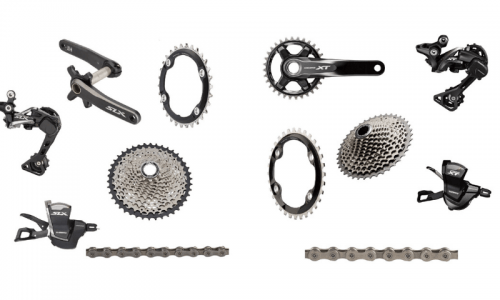Mountain biking is hard on bikes. The bumps, vibrations and inevitable crashes on the trails all take their toll on your frame and components, and – if you ride with any degree of regularity – drivetrain parts on your mountain bike will eventually succumb to the ravages of off-road riding and require replacement.
When it comes to budget options, Shimano’s mid-tier mountain bike groupsets offer not only fantastic value for money, but are also engineered and manufactured to withstand the tough nature of off-road riding and offer reliability and longevity.
In this article we have a look at what the latest iterations of Shimano’s two famous mid-range groupsets, Deore and SLX, have to offer, the riding applications to which they’re best suited and the differences between them.
Shimano Deore

The Deore brand has been a household name among mountain bikers the world over for a long time. Deore components sit right in the middle of Shimano’s component hierarchy, below SLX and above the upper end of the entry level groupsets, Alivio.
The latest versions of Deore not only bring 12-speed wide ratio drivetrain to the masses at a very affordable price point, but Shimano also diversified the offerings within the Deore range to feature options for various riding applications. There are actually four subgroups of the current Deore range:
- Deore 6100 series: 12-speed mountain bike groupset with 1x cranks only
- Deore 5100 series: 11-speed mountain bike groupset with 1x and 2x cranks
- Deore 4100 series: 10-speed mtb groupset with 1x and 2x cranks
- Deore LinkGlide: This is an enhanced-durability version of Deore 10s aimed at bikes that see high mileage or hard use, like mid-range to high-end commuter bikes and eBikes.
Within all Deore subgroups you will find the usual trigger shifter pods, hydraulic brake system and cassettes/cranksets with the corresponding number of chainrings/cogs to match your chosen number of gears. There is even a Deore-level dropper post remote levers!
Shimano SLX
The venerable Shimano SLX might be, in my opinion, the groupset with the best price/performance ratio on the mountain bike component market. You get a lot for your hard-earned cash with SLX groupset. Several features come straight from Shimano’s more premium groupsets, XT and XTR.
The differences between SLX and Deore at the 12-speed level is mainly in weight and aesthetics. SLX parts look a little bit more refined, and the SLX cassette gets an alloy spider which saves about 67g in weight compared to its Deore counterpart. The same holds true across the component range with SLX being slightly lighter.
Which should you choose: SLX vs Deore?
You can’t go wrong with either groupset for a solid budget mountain bike build. Both groupsets do miss out on some premium features found at XT and XTR levels, like lacking the ability to do two gear upshifts with a single press of the shifter paddle, and the rear derailleur clutch (which maintains the chain under tension across the gear range to minimize chain slap and improve chain retention) is not adjustable on SLX and Deore, unlike XT and XTR’s adjustable tension derailleur clutches.
What you will be getting with going with SLX over Deore is:

1. Some weight savings: The most significant differences are in the cassette and crankset. Other SLX parts are marginally lighter compared to Deore, and while SLX and Deore components are far from weight weenie land, all know the small weight differences do add up. If you’re building a budget XC race bike, SLX might be worth it.
2. SLX hydraulic disc brakes have a tool-free reach adjust and ceramic pistons (vs metallic piston on Deore).
On many bikes, reach might be a set-and-forget thing, but the tool-free adjustment is convenient (for example if the bike is being used by multiple people or used as part of a shop’s rental fleet, such on-the-fly adjustments are very convenient). Ceramic pistons have better thermal dissipation properties and are lighter.

3. SLX has a slightly more refined design and a nicer looking finish.
Keep in mind that both SLX 7100 series as well as Deore 6100 series 12s, like other Shimano’s 12s groupsets, requires the new MicroSpline freehub body. If you wish to avoid a wheelset or freehub upgrade, you should consider either the Deore 5100 (11s) series or the older SLX 7000 (11s) series.
If you’re building a hard-use commuter which will see a share of off-road action, then the Deore LinkGlide series would be the perfect match.
Also, remember that you can mix and match parts from both groupsets, and that’s components from the same generation and number of speeds (e.g. 7100 and Deore 6100) are cross compatible. This means that you can, say, have a Deore shifter paired with SLX derailleur (and vice versa).

Hani Morsi is a seasoned multi-discipline cyclist with a particular liking for mountain and gravel bikes. Hani is also a mountain bike coach, trail builder and experienced bike mechanic.


